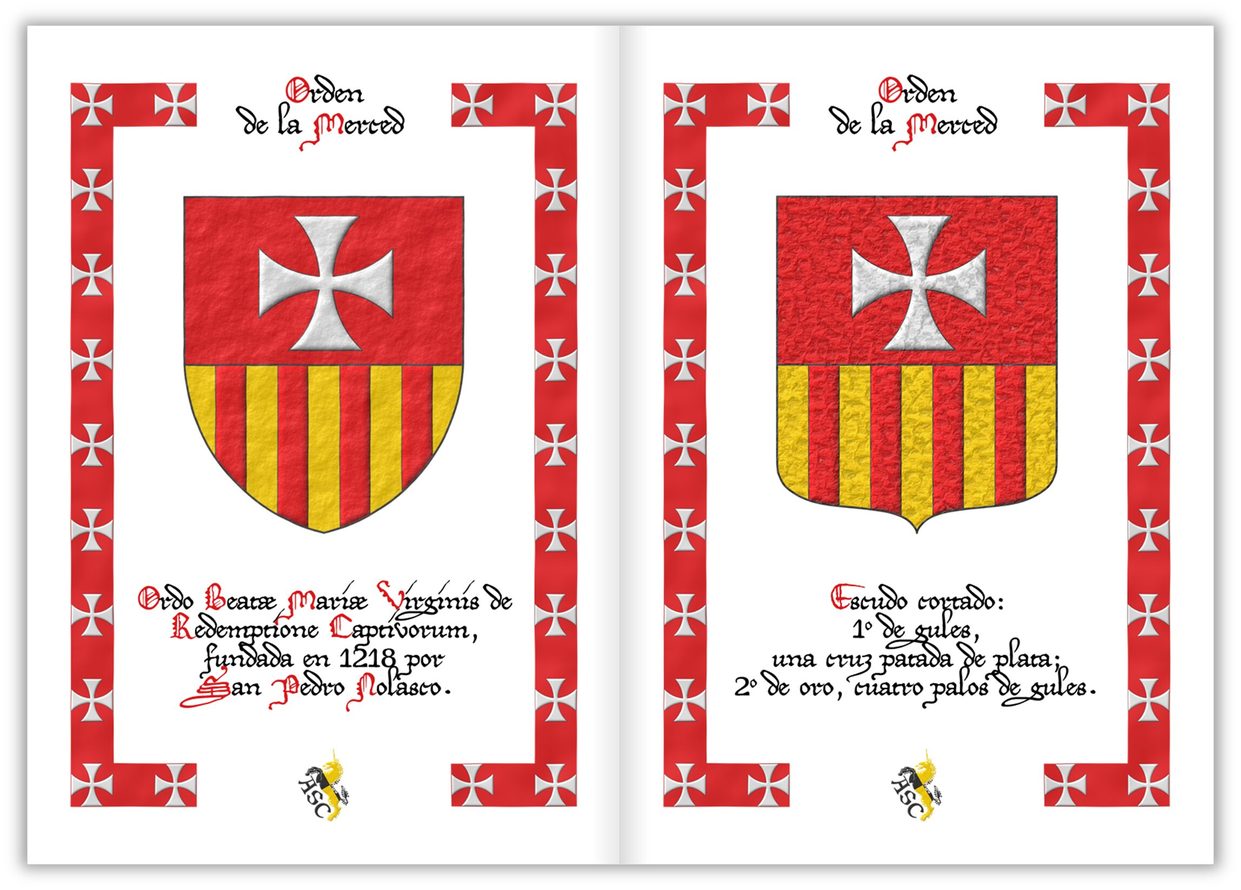
![Ver [Rowling, J. K.; 1997] en referencias bibliográficas. Libro abierto, hojas de plata, filo de oro, guardas de gules, tapas de sable.](../css/Libro.Bibliografia.png)
Rowling, J. K.; 1997
J. K. Rowling, «Harry Potter and the Philosopher’s Stone», London Bloomsbury, London, 1997.
Bibliographical reference of century XX.
Author: Rowling, Joanne.
The following articles cite this bibliographic reference:


Our Lady of Mercy, Order of
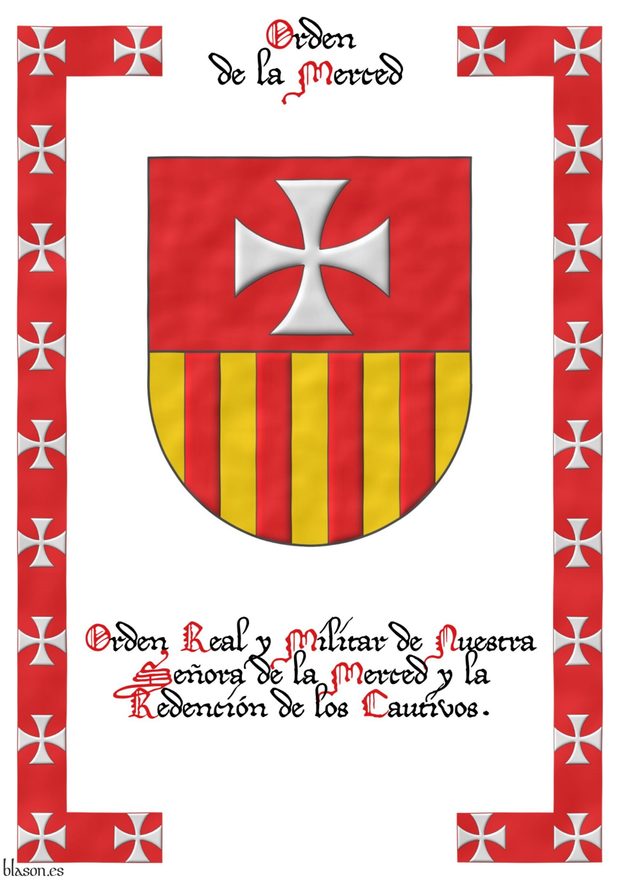
Royal and Military Order of Our Lady of Mercy and the Redemption of Captives.
Party per fess: 1 Gules, a cross patty Argent; 2 Or, four pallets Gules.
Escudo cortado: 1o de gules, una cruz patada de plata; 2o de oro, cuatro palos de gules.
Existing coat of arms which has been interpreted by me with the following characteristics: the mouth of the shield ends in a semicircular arch shape; the field has been enameled with flat tinctures of Gules color and Or metal; the cross patty and the pales are illuminated with Argent metal and Gules color; the whole has received a watercolor finish; and all within a Gules frame with 22 cross patties Argent, to which the name of its owner and blazon written in Sable and Gules tinctures is added.
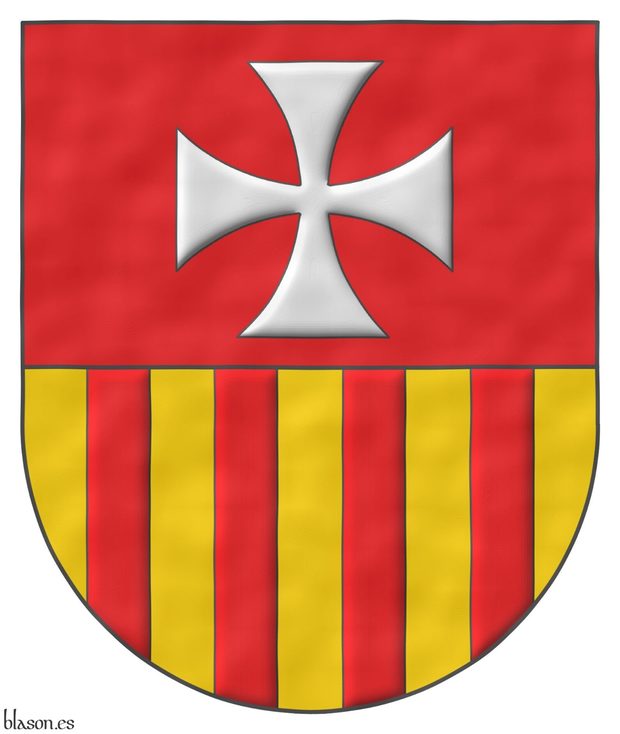
In [Medél, R.; 1846; plate 35, illustration 7] can be seen his interpretation of the coat of arms of the Order of Mercy.
The 2nd coat of arms of the Order of Mercy also illustrating this article is the same as the one included within the frame that appears in the 1st illustration of this article.
Another way to write the blazon of the coat of arms of the Order of Mercy could be the following, which simplifies the description of the 2nd quarter by saying that they are the arms of Aragon:
Party per fess: 1 Gules, a cross patty Argent; and 2 Or, four pallets Gules.
This coat of arms has been classified within the category called religious heraldry.
Blazon keywords: Party per fess, Gules, Or, Argent, Cross, One, Cross patty, Cross couped and Pale.
Style keywords: Semi-circular, Illuminated, Outlined in sable and Watercolor.
Classification: Interpreted, Religious and Frame.
Bearer: Our Lady of Mercy, Order of.


Order of Mercy
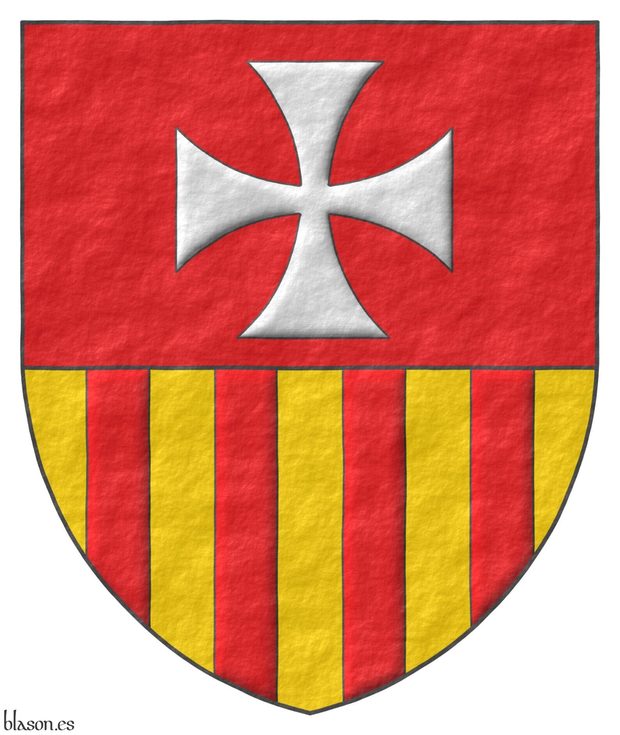
Ordo Beatæ Mariæ Virginis de Redemptione Captivorum
Party per fess: 1 Gules, a cross patty Argent; 2 Or, four pallets Gules.
Escudo cortado: 1o de gules, una cruz patada de plata; 2o de oro, cuatro palos de gules.
These already existing arms have been interpreted by me in the following way: the mouth of the coat of arms has been drawn in a pointed shape; its field has been enameled with Gules and Or flat tinctures; the cross patty and the 4 pales are illuminated; and the whole has received a rough finish.
Blazon keywords: Party per fess, Gules, Or, Argent, Cross, One, Cross patty, Cross couped and Pale.
Style keywords: Pointed, Illuminated, Outlined in sable and Rough.
Classification: Interpreted, Religious and Coat of arms.
Bearer: Our Lady of Mercy, Order of.


Order of Mercy, pointed and rounded
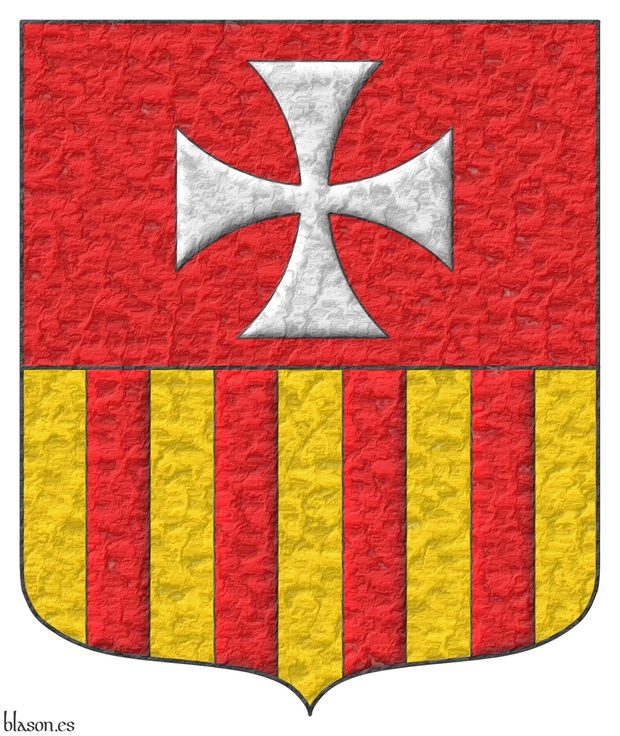
Order founded in 1218 by Saint Peter Nolasco.
Party per fess: 1 Gules, a cross patty Argent; 2 Or, four pallets Gules.
Escudo cortado: 1o de gules, una cruz patada de plata; 2o de oro, cuatro palos de gules.
Already existing arms interpreted by me in the following way: the mouth of the coat of arms is pointed and rounded; its field has been enameled with Gules and Or flat tinctures; the cross patty and the 4 pales are illuminated; and the whole coat of arms has a hammered metal finish.
Blazon keywords: Party per fess, Gules, Or, Argent, Cross, One, Cross patty, Cross couped and Pale.
Style keywords: Ogee, Illuminated, Outlined in sable and Metal beaten.
Classification: Interpreted, Religious and Coat of arms.
Bearer: Our Lady of Mercy, Order of.


Order of Mercy, rounded and crystalline
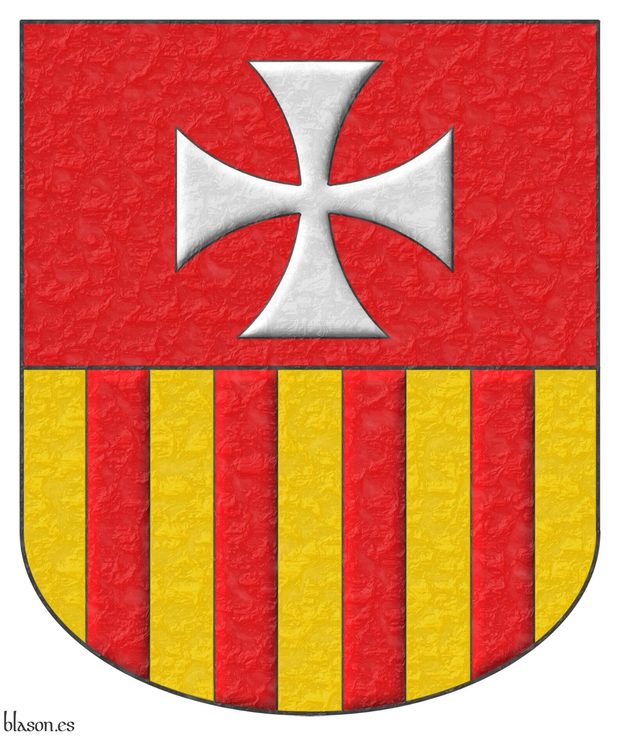
Party per fess: 1 Gules, a cross patty Argent; 2 Or, four pallets Gules.
Escudo cortado: 1o de gules, una cruz patada de plata; 2o de oro, cuatro palos de gules.
Already existing arms interpreted by me in the following manner: the mouth of the coat of arms is rounded in shape; the field has been enameled with Gules and Or flat tinctures; its cross patty and its 4 pales are illuminated; and the whole has received a crystalline finish.
The redemptive mission of the Order of Mercy, founded by Peter Nolasco on August 10, 1218, is represented by a cross Argent, a symbol of innocence and purity, on a field Gules, of blood ready to be shed, and the pales Gules, symbols of love and charity, on a field Or, are an expression of nobility and goodness.
Blazon keywords: Party per fess, Gules, Or, Argent, Cross, One, Cross patty, Cross couped and Pale.
Style keywords: Rounded, Illuminated, Outlined in sable and Crystalline.
Classification: Interpreted, Religious and Coat of arms.
Bearer: Our Lady of Mercy, Order of.


Order of Mercy, rounded and cloth-like
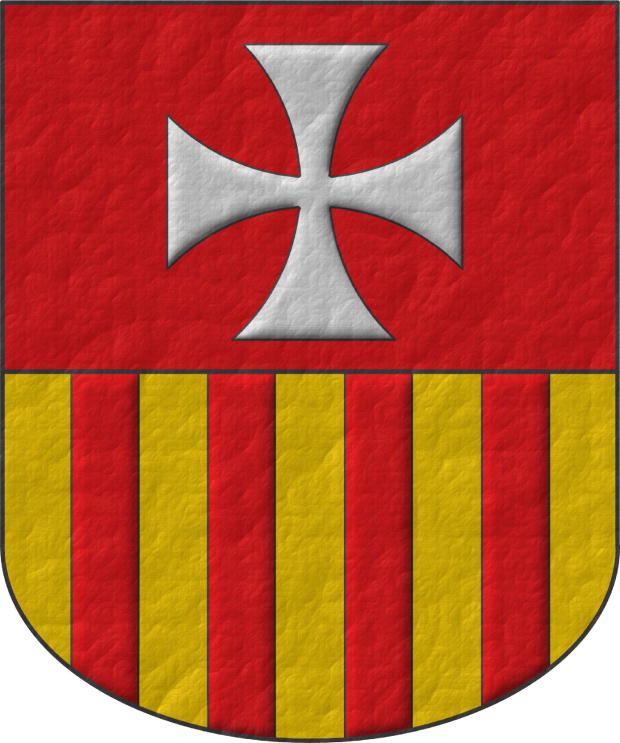
Party per fess: 1 Gules, a cross patty Argent; 2 Or, four pallets Gules.
Escudo cortado: 1o de gules, una cruz patada de plata; 2o de oro, cuatro palos de gules.
These already existing arms have been interpreted with: the mouth of the coat of arms rounded; its field has received an enamel of flat tincture style, of Gules color and Or metal; its cross patty and its 4 pales are illuminated; and the whole coat of arms has received a cloth-like finish.
The party per fess coat of arms of the Royal and Military Order of Our Lady of Mercy and the Redemption of Captives is the fusion of 2 gifts: the cross patty that was donated to the Order by Bishop Berenguer de Palou on the day of its foundation and the coat of arms of Aragon that King James I of Aragon, the Conqueror, also present at the ceremony, on August 10, 1218, gave to the Order as a symbol of support for the redemptive work of Peter Nolasco.
Blazon keywords: Party per fess, Gules, Or, Argent, Cross, One, Cross patty, Cross couped and Pale.
Style keywords: Rounded, Illuminated, Outlined in sable and Fabric.
Classification: Interpreted, Religious and Coat of arms.
Bearer: Our Lady of Mercy, Order of.


Order of Mercy, decorative frame on 2 pages
Gules frame charged with 22 cross patties Argent; 11 crosses on each side; and written in Sable letters with Gules capital letters;
Blazon keywords: Party per fess, Gules, Or, Argent, Cross, One, Cross patty, Cross couped and Pale.
Classification: Interpreted, Religious and Frame.
Bearer: Our Lady of Mercy, Order of.


Order of Mercy, heraldic catalog
This heraldic catalog has 6 DIN A4 format pages; 3 of the pages framed in Gules and with 22 cross patties Argent; includes 5 different heraldic shields for color printing; and with Sable texts with highlights in Gules.
Blazon keywords: Party per fess, Gules, Or, Argent, Cross, One, Cross patty, Cross couped and Pale.
Classification: PDF, Interpreted, Religious, Catalogue and Heraldic document.
Bearer: Our Lady of Mercy, Order of.

Continue with: Castile and León.
-
Language
-
Categories of heraldry
-
Divisions of the field
- Without divisions
- Party per pale
- Party per fess
- Party per bend
- Party per bend sinister
- Tierce
- Tierce sinister
- Tierced per pale
- Tierced per fess
- Tierced per bend
- Tierced pallwise inverted
- Quarterly
- Quarterly per saltire
- Gyronny
- Party per fess, the chief per pale
- Party per pale, the sinister per fess
- Party per fess, the base per pale
- Party per pale, the dexter per fess
- Chapé
- Chaussé
- Embrassé
- Contre-embrassé
- Party per chevron
- Enté
- Enté en point
- Flanched
-
Metals
-
Colours
-
Furs
-
Other tinctures
-
Ordinaries and sub-ordinaries
-
Diminutives of the ordinaries
-
Geometric charges
-
Composite ordinaries
-
Inanimate charges from Nature
Atom, Crescent, Diamond, Emerald, Estoile, Increscent, Lightning flash, Moon, Mount, Mullet, Mullet of four points, Orbital, Plough of Ursa Major, Rainbow, Ray of the sun, River, Sea, Snowflake, Sun, Sun in splendour, Sun of May, Trimount, Water and Wave.
-
Vegetal charges from Nature
Acorn, Apple, Apple tree, Ash, Bluebonnet, Camellia, Chrysanthemum, Cinquefoil, Cornflower, Dogwood flower, Double rose, Elm, Fleur de lis, Flower, Gourd, Holm oak, Hop cone, Kapok tree, Laurel, Lily, Linden, Lotus flower, Madonna lily, Mexican cedar tree, Oak, Olive tree, Palm tree, Plantain plant, Pomegranate, Poplar leaf, Rose, Shamrock, Sunflower, Thistle, Tree, Tulip, Vine and Wheat.
-
Animal charges from Nature
Badger, Bald eagle, Barbel, Barn owl, Bear, Beaver, Beetle, Bighorn sheep, Blackbird, Boar, Brach hound, Bull, Doe, Dog, Dolphin, Dove, Eagle, Elephant, Falcon, Female figure, Fish, Flame, Fly, Fox, Frog, Goat, Goldfinch, Goose, Heron, Horse, Hummingbird, Jaguar, Lark, Leopard, Lion, Lion passant, Lion rampant guardant, Lioness, Lynx, Male figure, Martlet, Merino ram, Owl, Panther, Parrot, Peacock, Pelican, Pelican in her piety, Puffin, Quetzal, Raven, Roe deer, Rooster, Savage, Seagull, Serpent, She-wolf, Stag, Starling, Talbot, Tyger, Vulture, Warren hound and Wolf.
-
Parts of natural charges
Arm, Beak, Branch, Caboshed, Chest, Claw, Covert, Dorsal fin, Eagle claw, Ermine spot, Escallop, Feather, Foot (palmiped), Foreleg, Forepaw, Hand, Head, Heart, Hoof, Leaf, Neck, Ostrich feather, Palm frond, Paw, Roe deers' attires, Shoulder, Sprig, Stags' attires, Stem, Swallow-tail, Tail, Tail addorsed, Tail fin, Talon, Tibia, Tooth, Trunk, Trunk (elephant), Two hands clasped, Two wings in vol, Udder, Wheat spike, Wing and Wrist.
-
Artificial charges
Ace of spades, Anchor, Anvil, Arch, Arm vambraced, Armillary sphere, Arrow, Axe, Bell, Bell tower, Beret, Bonfire, Book, Bookmark, Bow, Branding iron, Bridge, Broken, Buckle, Cannon, Cannon dismounted, Cannon port, Canopy roof, Carbuncle, Castle, Celtic Trinity knot, Chain, Chess rooks, Church, Clarion, Clay pot, Closed book, Club, Column, Comb, Compass rose, Conductor's baton, Cord, Covered cup, Crozier, Crucible, Cuffed, Cup, Cyclamor, Dagger, Double vajra, Drum, Ecclesiastical cap, Fanon, Federschwert, Fleam, Four crescents joined millsailwise, Galician granary, Garb, Gauntlet, Geometric solid, Grenade, Halberd, Hammer, Harp, Host, Hourglass, Key, Key ward, Knight, Knot, Lantern, Letter, Line, Loincloth, Menorah, Millrind, Millstone, Millwheel, Monstrance, Mortar, Mullet of six points pierced, Nail, Non-classic artifact, Norman ship, Number, Oar, Oil lamp, Open book, Page, Pair of scales, Parchment, Pestle, Piano, Pilgrim's staff, Plough share, Polish winged hussar, Port, Portcullis, Potent, Quill, Ribbon, Rosette of acanthus leaves, Sabre, Sackbut, Sail, Scroll, Scythe, Sheaf of tobacco, Ship, Skirt, Spear, Spear's head, Stairway, Star of David, Step, Sword, Symbol, Tetrahedron, Torch, Tower, Trident, Trumpet, Turret, Two-handed sword, Wagon-wheel, Water-bouget, Wheel, Winnowing fan and With a turret.
-
Immaterial charges
Angel, Archangel, Basilisk, Dragon, Dragon's head, Garuda, Golden fleece, Griffin, Heart enflamed, Justice, Mermaid, Our Lady of Mercy, Ouroboros, Paschal lamb, Pegasus, Phoenix, Sacred Heart of Jesus, Saint George, Sea-griffin, Trinity, Triton, Unicorn, Winged hand and Wyvern.
-
External elements
-
Heraldic creations
-
References
-
Formats
-
Keywords on this page
Port and windows, Watercolor, Pointed, Armed, Azure, Bibliography, Castile and León, Castle, Catalogue, Ogee, Crowned, Party per fess, Crystalline, Cross, Cross patty, Cross couped, Quarterly, Outlined in sable, Heraldic document, Fabric, Coat of arms, Gules, Illuminated, Interpreted, Langued, Lion, Frame, Masoned, Semi-circular, Metal beaten, Or, Our Lady of Mercy, Order of, PDF, Pale, Canting, Argent, Civic, Purpure, Rampant, Rounded, Kingdom of Castile and Leon, Religious, Rough, Sable, Century XX, Plain tincture and One.

